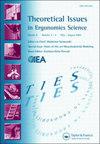Application of interpretive structural modelling (ISM) for developing ergonomic workstation improvement framework
IF 1.4
Q4 ERGONOMICS
引用次数: 0
Abstract
Abstract With increasing frequency and intensity of Musculoskeletal disorders(MSDs) and large number of people being affected by them, the subject of workstation design needs required more attention and a planned approach. In order to reduce the adverse impact of disorders and to improve the existing workstation design practices, academicians and practitioners are emphasizing on a number of diverse factors of workstation design/improvement by segmenting them into different clusters. This research is intended to address the critical contributing success factors (CCSFs). Through a review of literature and expert consultation, twenty-four critical contributing success factors leading to ergonomic workstation design have been identified. In this paper, the authors have used Interpretive Structural Modelling (ISM) approach to interpret the interdependency among the selected CCSFs. In addition, MICMAC (Matrice d’Impacts Croisés Multiplication Appliquée á un Classement (cross-impact matrix multiplication applied to classification)) analysis is also performed to illustrate the relative driving and dependence power among the selected factors. This paper infers that, Capital availability is the most dominating factor which has the highest driving power and the minimum dependence power as it drives others factors and forms the base of interpretive structure model. This is followed by physical attributes including anthropometric dimensions of worker. The top-level dependent factors are safety and flexibility requirement for any workstation design. Originality: ISM and MICMAC analysis applied in workstation design and is not available in the literature having twenty-four factors.应用解释结构模型(ISM)开发人机工效工作站改进框架
随着肌肉骨骼疾病(MSDs)发生频率和强度的增加以及受其影响的人群数量的增加,工作站的设计需要更多的关注和有计划的方法。为了减少疾病的不利影响并改进现有的工作站设计实践,学者和从业者正在通过将它们划分为不同的集群来强调工作站设计/改进的许多不同因素。本研究的目的是解决关键贡献成功因素(ccsf)。通过文献回顾和专家咨询,24个关键贡献成功因素导致人体工程学工作站的设计已经确定。在本文中,作者使用解释结构建模(ISM)方法来解释所选ccsf之间的相互依赖性。此外,我们还进行了MICMAC (matrix d’impacts croiscims Multiplication appliqucame un Classement(交叉影响矩阵乘法应用于分类)分析,以说明所选因素之间的相对驱动和依赖能力。本文认为,资本可获得性是最主要的因素,对其他因素的驱动力最大,依赖性最小,构成了解释结构模型的基础。其次是身体属性,包括工人的人体测量尺寸。最顶层的依赖因素是任何工作站设计的安全性和灵活性要求。原创性:将ISM和MICMAC分析应用于工作站设计,在文献中没有24个因素。
本文章由计算机程序翻译,如有差异,请以英文原文为准。
求助全文
约1分钟内获得全文
求助全文

 求助内容:
求助内容: 应助结果提醒方式:
应助结果提醒方式:


